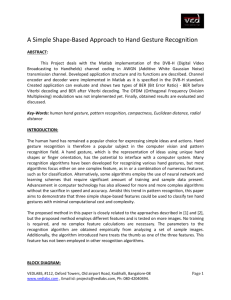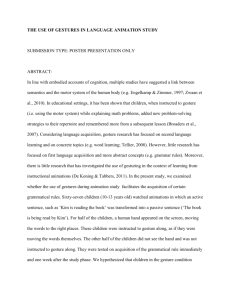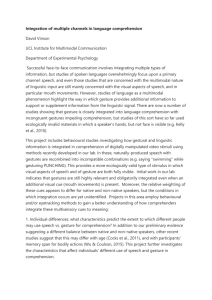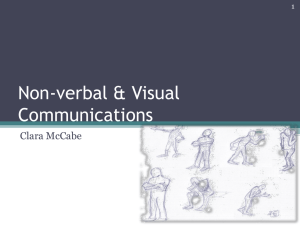1 Evaluating physical discomfort associated with
advertisement
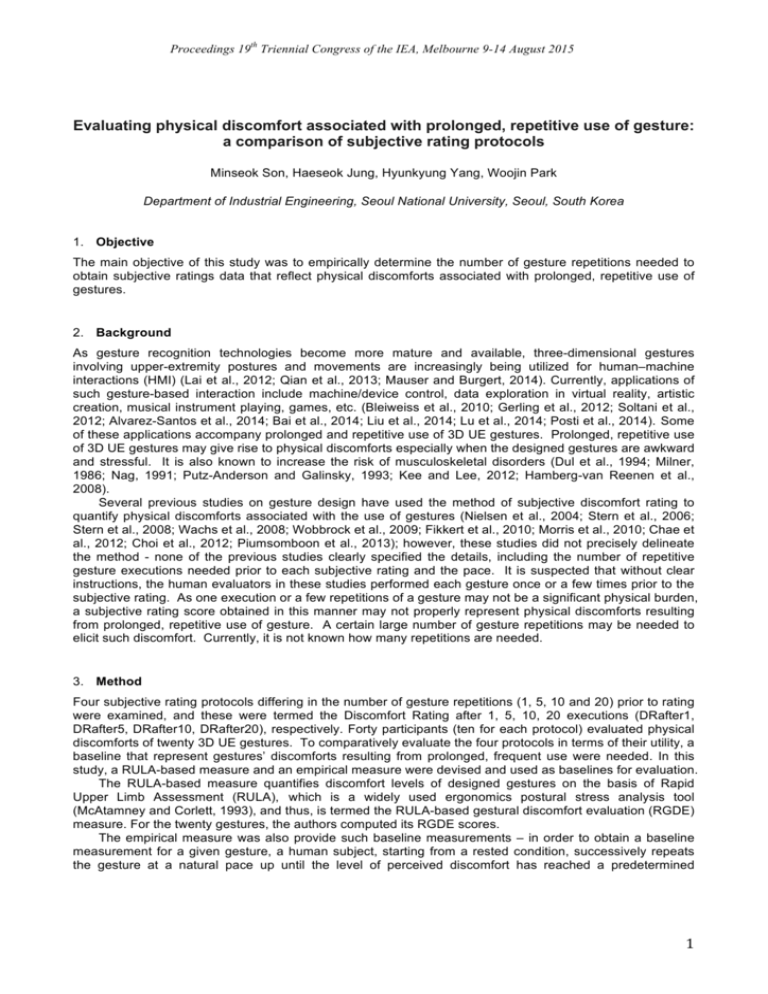
Proceedings 19th Triennial Congress of the IEA, Melbourne 9-14 August 2015 Evaluating physical discomfort associated with prolonged, repetitive use of gesture: a comparison of subjective rating protocols Minseok Son, Haeseok Jung, Hyunkyung Yang, Woojin Park Department of Industrial Engineering, Seoul National University, Seoul, South Korea 1. Objective The main objective of this study was to empirically determine the number of gesture repetitions needed to obtain subjective ratings data that reflect physical discomforts associated with prolonged, repetitive use of gestures. 2. Background As gesture recognition technologies become more mature and available, three-dimensional gestures involving upper-extremity postures and movements are increasingly being utilized for human–machine interactions (HMI) (Lai et al., 2012; Qian et al., 2013; Mauser and Burgert, 2014). Currently, applications of such gesture-based interaction include machine/device control, data exploration in virtual reality, artistic creation, musical instrument playing, games, etc. (Bleiweiss et al., 2010; Gerling et al., 2012; Soltani et al., 2012; Alvarez-Santos et al., 2014; Bai et al., 2014; Liu et al., 2014; Lu et al., 2014; Posti et al., 2014). Some of these applications accompany prolonged and repetitive use of 3D UE gestures. Prolonged, repetitive use of 3D UE gestures may give rise to physical discomforts especially when the designed gestures are awkward and stressful. It is also known to increase the risk of musculoskeletal disorders (Dul et al., 1994; Milner, 1986; Nag, 1991; Putz-Anderson and Galinsky, 1993; Kee and Lee, 2012; Hamberg-van Reenen et al., 2008). Several previous studies on gesture design have used the method of subjective discomfort rating to quantify physical discomforts associated with the use of gestures (Nielsen et al., 2004; Stern et al., 2006; Stern et al., 2008; Wachs et al., 2008; Wobbrock et al., 2009; Fikkert et al., 2010; Morris et al., 2010; Chae et al., 2012; Choi et al., 2012; Piumsomboon et al., 2013); however, these studies did not precisely delineate the method - none of the previous studies clearly specified the details, including the number of repetitive gesture executions needed prior to each subjective rating and the pace. It is suspected that without clear instructions, the human evaluators in these studies performed each gesture once or a few times prior to the subjective rating. As one execution or a few repetitions of a gesture may not be a significant physical burden, a subjective rating score obtained in this manner may not properly represent physical discomforts resulting from prolonged, repetitive use of gesture. A certain large number of gesture repetitions may be needed to elicit such discomfort. Currently, it is not known how many repetitions are needed. 3. Method Four subjective rating protocols differing in the number of gesture repetitions (1, 5, 10 and 20) prior to rating were examined, and these were termed the Discomfort Rating after 1, 5, 10, 20 executions (DRafter1, DRafter5, DRafter10, DRafter20), respectively. Forty participants (ten for each protocol) evaluated physical discomforts of twenty 3D UE gestures. To comparatively evaluate the four protocols in terms of their utility, a baseline that represent gestures’ discomforts resulting from prolonged, frequent use were needed. In this study, a RULA-based measure and an empirical measure were devised and used as baselines for evaluation. The RULA-based measure quantifies discomfort levels of designed gestures on the basis of Rapid Upper Limb Assessment (RULA), which is a widely used ergonomics postural stress analysis tool (McAtamney and Corlett, 1993), and thus, is termed the RULA-based gestural discomfort evaluation (RGDE) measure. For the twenty gestures, the authors computed its RGDE scores. The empirical measure was also provide such baseline measurements – in order to obtain a baseline measurement for a given gesture, a human subject, starting from a rested condition, successively repeats the gesture at a natural pace up until the level of perceived discomfort has reached a predetermined 1 Proceedings 19th Triennial Congress of the IEA, Melbourne 9-14 August 2015 significant discomfort level, say, 5 (“strong”) on the 10-point scale. This number of repetitions prior to significant discomfort (shortly abbreviated as NRPSD or NRP5 if the predetermined discomfort level is 5 on the 10-point scale) becomes the baseline measurement. The NRPSD measure indicates how many times a gesture can be successively repeated before giving rise to significant discomfort, and, allows comparing different gestures’ discomfort levels in the context of prolonged, frequent use of gesture; a more stressful gesture results in a smaller value of NRPSD than a less stressful one. Sixteen participants in their 20s and 30s (13 males and 3 females) repeated each of the twenty gestures and the NRP5s were determined. Then, correlation analyses were performed to examine the relationship among four subjective rating protocols, RGDE and NRP5. 4. Results The mean DRafter1, mean DRafter5, mean DRafter10, mean DRafter20, RGDE scores and mean NRP5s determined for each of the twenty gestures were generated. The intercorrelations among the measures were provided in Table 1. All values were statistically significant (p-value<0.05). Table 1. The results of correlation analyses Measure RGDE Score Mean NRP5 Mean DRafter1 0.68 -0.85 Mean DRafter5 0.70 -0.61 Mean DRafter10 0.75 -0.74 Mean DRafter20 0.83 -0.84 5. Conclusion This study empirically investigated the number of gesture executions required prior to subject discomfort rating for accurate estimation of physical discomfort from prolonged, repetitive use of 3D UE gestures. The study’s findings indicate the DRafter20 measure has potential to be useful. The DRafter20 measure also has the advantage that data collection is not time-consuming. The DRafter20 measure may be useful for a variety of prolonged, repetitive physical tasks aside from gestural interaction. A future investigation on its applicability to other physical tasks seems to be warranted. References Alvarez-Santos, V., Iglesias, R., Pardo, X. M., Regueiro, C. V., & Canedo-RoDIRguez, A. 2014. “Gesture-based interaction with voice feedback for a tour-guide robot.” Journal of Visual Communication and Image Representation, 25(2), 499-509. Bai, H., Lee, G. A., Ramakrishnan, M., & Billinghurst, M. 2014. “3D gesture interaction for handheld augmented reality.” In SIGGRAPH Asia 2014 Mobile Graphics and Interactive Applications (p. 7). ACM. Bleiweiss, A., Eshar, D., Kutliroff, G., Lerner, A., Oshrat, Y., & Yanai, Y. 2010. “Enhanced interactive gaming by blending full-body tracking and gesture animation.” In ACM SIGGRAPH ASIA 2010 Sketches, 34. Chae J., Lee S., & Cho K. 2012. “A study of gesture vocabulary design for MP3 player depending on situations.” HCI Conference, 653-656. Choi, E., Kwon, S., Lee, D., Lee, H., & Chung, M. 2012. “Design of Hand Gestures for Smart Home Appliances based on a User Centered Approach.” Journal of the Korean Institute of Industrial Engineers, 38(3), 182-190. Dul, J., Douwes, M. and Smitt, P. 1994. “Ergonomic guidelines for the prevention of discomfort of static postures on endurance data.” Ergonomics, 37(5), 807-815. Fikkert, W., van der Vet, P., & Nijholt, A. 2010. “Gestures in an Intelligent User Interface.” In Multimedia Interaction and Intelligent User Interfaces, 215-242. Gerling, K., Livingston, I., Nacke, L., & Mandryk, R. 2012. “Full-body motion-based game interaction for older adults.” In Proceedings of the SIGCHI Conference on Human Factors in Computing Systems, 1873-1882. Hamberg-van Reenen, H. H., van der Beek, A. J., Blatter, B. M., van der Grinten, M. P., van Mechelen, W., & Bongers, P. M. 2008. “Does musculoskeletal discomfort at work predict future musculoskeletal pain?” Ergonomics, 51(5), 637-648. Kee, D., & Lee, I. 2012. “Relationships between subjective and objective measures in assessing postural stresses.” Applied Ergonomics, 43(2), 277-282. Lai, K., Konrad, J., & Ishwar, P. 2012. “A gesture-DIRven computer interface using Kinect.” In Image Analysis and Interpretation (SSIAI), 2012 IEEE Southwest Symposium, 185-188. 2 Proceedings 19th Triennial Congress of the IEA, Melbourne 9-14 August 2015 Liu, Y., Dong, C., Zhang, M., Chen, X., & Li, Y. 2014. “A Novel Music Player Controlling Design Based on Gesture Recognition.” Lu, Z., Chen, X., Li, Q., Zhang, X., & Zhou, P. 2014. “A Hand Gesture Recognition Framework and Wearable GestureBased Interaction Prototype for Mobile Devices.” Mauser, S., & Burgert, O. 2014. “Touch-Free, Gesture-Based Control of Medical Devices and Software Based on the Leap Motion Controller.” Medicine Meets Virtual Reality 21: NextMed/MMVR21, 196, 265. McAtamney, L., Corlett, E.N. 1993. “RULA: a survey method for the investigation of work-related upper limb disorders.” Appl. Ergon. 24(2), 91-99. Milner, N. 1986. “Modelling fatigue and recovery in static postural exercise.” Clinical Biomechanics, 1(1), 29. Morris, M. R., Wobbrock, J. O., & Wilson, A. D. 2010. “Understanding users' preferences for surface gestures.” In Proceedings of graphics interface 2010, 261-268. Nag, P. K. 1991. “Endurance limits in different modes of load holding.” Applied ergonomics, 22(3), 185-188. Nielsen, M., Störring, M., Moeslund, T. B., & Granum, E. 2004. “A procedure for developing intuitive and ergonomic gesture interfaces for HCI.” In Gesture-Based Communication in Human-Computer Interaction, 409-420. Piumsomboon, T., Clark, A., Billinghurst, M., & Cockburn, A. 2013. “User-defined gestures for augmented reality.” In Human-Computer Interaction–INTERACT 2013, 282-299. Posti, M., Ventä-Olkkonen, L., Colley, A., Koskenranta, O., & Häkkilä, J. 2014. “Exploring Gesture Based Interaction with a Layered Stereoscopic 3D Interface.” In Proceedings of the International Symposium on Pervasive Displays (p. 200). ACM. Putz-Anderson, V., & Galinsky, T. L. 1993. “Psychophysically determined work durations for limiting shoulder girdle fatigue from elevated manual work.” International Journal of Industrial Ergonomics, 11(1), 19-28. Qian, K., Niu, J., & Yang, H. 2013. “Developing a Gesture Based Remote Human-Robot Interaction System Using Kinect.” International Journal of Smart Home, 7(4). Soltani, F., Eskandari, F., & Golestan, S. 2012. “Developing a gesture-based game for deaf/mute people using Microsoft kinect.” In Complex, Intelligent and Software Intensive Systems (CISIS), 2012 Sixth International Conference, 491495. Stern, H. I., Wachs, J. P., & Edan, Y. 2006. “Human factors for design of hand gesture Human-Machine Interaction.” In Systems, Man and Cybernetics, 2006. SMC'06. IEEE International Conference, Vol. 5, 4052-4056. Stern, H. I., Wachs, J. P., & Edan, Y. 2008. “Designing hand gesture vocabularies for natural interaction by combining psycho-physiological and recognition factors.” International Journal of Semantic Computing, 2(01), 137-160. Wachs, J., Stern, H., & Edan, Y. 2008. “A Holistic Framework for Hand Gestures Design.” In Proceedings of 2nd Annual Visual and Iconic Language Conference, 24-34. Wobbrock, J. O., Morris, M. R., & Wilson, A. D. 2009. “User-defined gestures for surface computing.” In Proceedings of the SIGCHI Conference on Human Factors in Computing Systems, 1083-1092. 3




